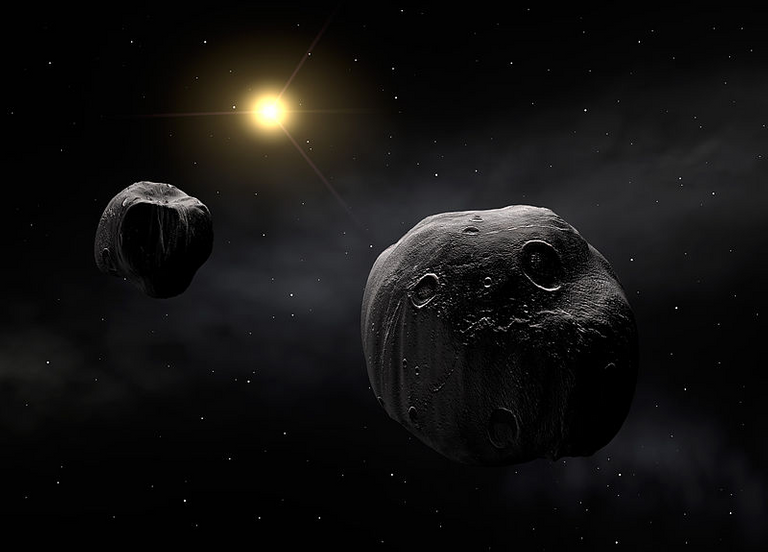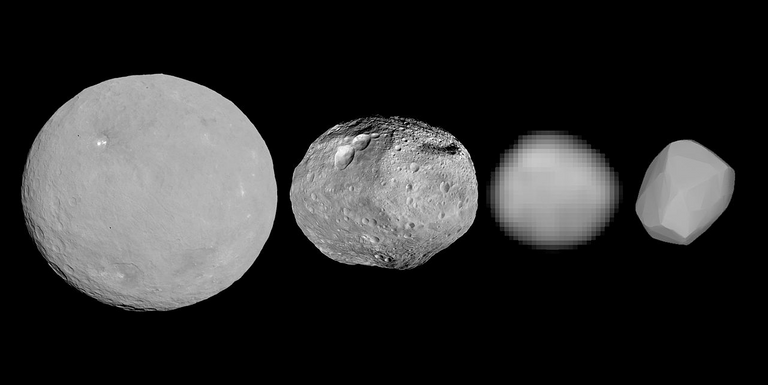Back in those days when I was a toddler, I and my peers would gather under dark but starry sky at night and begin to theorize on what lies up there. We do believe that stars do sometimes lose balance and get ejected from their placement holders and this is what consistute some strange movement of sudden light in the dark sky.
Beyond earth and the world that we see with our eyes lies outer space including some of the most mind-boggling things you never even thought existed. Chances are you have heard of asteroids a couple of times. There are so many questions about asteroids scientists are yet to answer. Are they balls of gases? Will any land on earth soon? Can asteroids wipe out life on earth if they land here? Are they space elements we should be worried about? The curiosity revolving around this particular space element is twice that of a cat's. However, this article will give detailed facts and information about asteroids.

Asteroids are small rock-like worlds revolving around the sun. Scientists say that they are airless excesses left over from the early formation of the solar system dating back to almost 5 billion years ago. Astronomers would have called them planets if only they were not too small to earn the title but they are known as tiny planets or planetoids. It turns out they earned a part of the title after all. Outerspace is home to millions of asteroids ranging from hundreds of miles to numerous feet across. The cumulative mass of asteroids is relatively less than that of earth's sole natural satellite – the moon.
The ancient small space bodies have been triggering the most comprehensive research for centuries. On January 1, 1801, the first asteroid was discovered by Giuseppe Piazzi, an Italian Catholic priest of the Theatine order, a mathematician, and an astronomer.
These dwarf planets are grouped into three main groups (C-type, S-type, and M-type)depending on their carbon content, metal composition, and silicon quantity.
C-type
It is believed that these types of minor planets are the most commonly seen types floating in outer space. They consist of about 75% of the presumed asteroid population and also dominate the outer part of the asteroid belt. (The asteroid belt is a region in the solar system shaped like a torus, found somewhere between the orbits of the planets Jupiter and Mars, greatly occupied by asteroids). Every carbonaceous asteroid (asteroids containing a large amount of carbon with other rocks and minerals) occupies this category. C-type asteroids are typically dark with their reflection coefficient running from 0.03 to 0.10
S-type
These types of mini planets can be found in the inner part of the asteroid belt. They are also the most common after the C-type asteroids. As the name suggests, they are dwarf planets with a spectral type that is expressive of a stony mineralogical character. Circa 17% of asteroids are of the S-type. They are moderately bright asteroids with their reflection varying from 0.10 to 0.22 with major components such as iron and magnesium silicates.
M-type
These types of asteroids are those containing nickel and iron in their raw and purest form. Sometimes, scientists discover some mixed with stones. We might know that they are common but we do not know a lot about them. Most M-type asteroids are fairly bright, with an albedo running between 0.1 and 0.2. They account for approximately 8% of known asteroids. And the largest known M-type asteroid is 16 Psyche, with a diameter of 200 km / 120 mi. It is one of the ten most massive asteroids that can be found in the asteroid belt.
Should We Worry About The Rocks In Our Solar System Hitting Earth?
So many individuals think of the creepiest and hair-raising scenarios about asteroids at the slightest report of one moving close to the earth. While some think asteroids pose a threat to life on earth, others are finding it difficult to comprehend what truly lies in those space rocks. Now, just to put you at ease, the chances of an asteroid hitting earth sooner or later can be compared to the number of humans killed by unicorns annually. In other words, the chances of a space rock landing on earth are very slim. However, it is noteworthy that it is not impossible.

Outer space holds numerous elements and could decide to send one down to earth for a quick visit. This is why astronomers and scientists are making in-depth research about space elements, their components, their effects should they come in contact with life on earth, and how to avoid them.
Space agencies like the National Aeronautics and Space Administration, (NASA) and the European Space Agency (ESA) are constantly making research and are on the lookout for the slightest asteroid movement directed towards the earth. The moment they notice close approaches of an asteroid, it is immediately put on a watch list and the chances of its impact are calculated to guarantee that none of these space rocks slip out of the belt. Even though spotting an asteroid can be tasking due to the blind spot the sub creates, these space agencies are unrelenting.
There is no need to worry over the mini planets. Advancement in technology at our fingertips can do something about any of these space rocks getting too close to the earth.
References
- https://solarsystem.nasa.gov/asteroids-comets-and-meteors/asteroids/overview/?page=0&per_page=40&order=name+asc&search=&condition_1=101%3Aparent_id&condition_2=asteroid%3Abody_type%3Ailike
- https://www.sciencefocus.com/space/the-sky-is-falling-should-you-be-worried-about-asteroids-and-comets/
- https://www.businessinsider.in/science/space/news/what-is-asteroid-and-why-asteroids-are-important-in-solar-system/articleshow/76683554.cms
- https://m.economictimes.com/definition/asteroids
Thanks for your contribution to the STEMsocial community. Feel free to join us on discord to get to know the rest of us!
Please consider supporting our funding proposal, approving our witness (@stem.witness) or delegating to the @stemsocial account (for some ROI).
Please consider using the STEMsocial app app and including @stemsocial as a beneficiary to get a stronger support.
Your post has been voted as a part of Encouragement program. Keep up the good work!
Use Ecency daily to boost your growth on platform!
Support Ecency
Vote for Proposal
Delegate HP and earn more